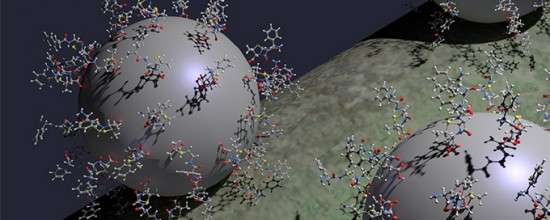Nanoparticles coated with antibiotic eliminate drug-resistant bacteria

A new strategy to combat antibiotic-resistant bacteria has been described by Brazilian researchers in Scientific Reports, an online journal owned by Springer Nature.
The method consists of coating nanoparticles that are made of silver and silica—potentially toxic to both microorganisms and human cells—with a layer of antibiotic. Owing to chemical affinity, the resulting nanopharmaceutical acts only on the pathogens and is inert to the organism.
"We used the antibiotic as a sort of bait to have the nanoparticles target the bacteria with a large amount of the drug. The combined action of the drug with the silver ions proved capable of killing even resistant microorganisms," said Mateus Borba Cardoso, a researcher at the National Energy & Materials Research Center (CNPEM).
The project is supported by FAPESP and is part of a line of research that aims to develop systems to make the action of nanoparticles selective.
In previous articles, the group showed that nanoparticles can also be used to make anti-cancer chemotherapy more effective by delivering the drug directly to tumor cells and leaving healthy cells intact. The nanoparticles could also be applied to potentially inactivate HIV in transfusion blood bags, for example.
"There are commercial drugs that contain nanoparticles, which typically serve to coat the active ingredient and extend its lifetime inside the organism. Our strategy is different. We decorate the surface of the nanoparticles with certain chemical groups that direct them to the site where they're designed to act, so they're highly selective," Cardoso said.
In the most recent article, the group described a scheme to synthesize nanoparticles consisting of a silver core overlaid with porous silica to allow the passage of ions. Several molecules of the antibiotic ampicillin were applied to the surface in an arrangement that, according to Cardoso, was far from random.
"We used molecular modeling to find out which part of the ampicillin molecule interacted most with the bacterial membrane," he said. "We then arranged all the molecules of the drug so that this key part was facing outward from the nanoparticle, increasing the likelihood of interaction with the pathogen."
Hubert Karl Stassen, of the Chemistry Institute at the Federal University of Rio Grande do Sul (UFRGS), collaborated on the molecular modeling stage.
The effectiveness of the nanoantibiotic compared with that of conventional ampicillin was assessed using two different strains of Escherichia coli, a bacterium that normally inhabits the gut flora of mammals and that can cause food poisoning in certain situations.
In the non-resistant strain, nearly 100% of the microorganisms died when attacked both by ampicillin in its conventional form and by the drug combined with silver. In the resistant strain, however, only the nanoantibiotic was effective.
The next step was to test the effect on human kidney cells. The silver and silica nanoparticles without ampicillin proved highly toxic, while conventional ampicillin and ampicillin combined with silver were found to be equally safe.
"Confocal microscopy images show that besides being non-toxic, the nanoparticle coated with ampicillin doesn't interfere with the cell cycle. The phases of mitosis take their course without any alterations," Cardoso said.
In his view, the same strategy could be used to combat other bacterial species that have developed resistance to antibiotics. In addition, the drug applied to the surface of the nanoparticle can be varied in order to treat different types of infection.
However, the system has one drawback: because silver and silica are inorganic, the nanoparticles are not metabolized and thus tend to build up in the organism.
"We don't yet know where the build-up occurs or what effect it has," Cardoso said. "To find out, we'll need to do tests in animals. In any event, we're continuing to improve the system in order to make it safer."
One possibility would be to use a second antibiotic with a different component than silver in the core. Another would be to develop a nanoparticle small enough to be excreted in urine.
Meanwhile, Cardoso added, in its current form, the nanoantibiotic could be used to treat extreme cases, such as hospital infections that do not respond to conventional antibiotics.
More information: Jessica Fernanda Affonso de Oliveira et al, Defeating Bacterial Resistance and Preventing Mammalian Cells Toxicity Through Rational Design of Antibiotic-Functionalized Nanoparticles, Scientific Reports (2017). DOI: 10.1038/s41598-017-01209-1
Journal information: Scientific Reports
Provided by FAPESP





















